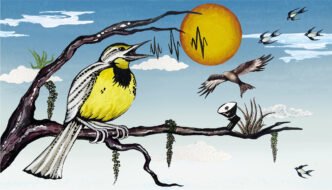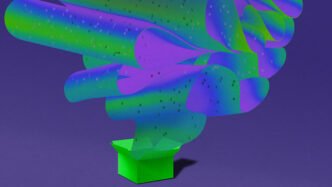A small songbird soars above Ithaca, New York, on a September night. He is one of 4 billion birds, part of a grand annual river of feathered migration across North America. Midair, he emits what ornithologists refer to as a nocturnal flight call, a vital form of communication among his flock. This brief signal, lasting barely 50 milliseconds, is captured in the dark woods by a specially designed microphone topped with a focusing funnel. Moments later, an advanced software system known as BirdVoxDetect—developed through a collaboration involving New York University, the Cornell Lab of Ornithology, and École Centrale de Nantes—identifies the bird and classifies it down to the species level.
For biologists like Andrew Farnsworth from Cornell, the dream of passively monitoring birds in this manner has become a reality. In a world increasingly shaped by climate change and human infrastructure, such as glass skyscrapers and power lines, migratory birds face numerous existential threats. To track their migration patterns effectively, scientists have relied on various methods, each with its unique limitations. While Doppler radar can measure the total biomass of birds in the air, it cannot discern species differences. GPS tagging has proven helpful, but it is expensive and often invasive, presenting a challenge for large-scale studies. Additionally, the fact that most birds migrate at night complicates visual identification, as many birdwatchers are asleep.
Over the past century, acoustic monitoring has stood at the forefront of potential solutions yet remained out of reach for ornithologists. In the late 1800s, scientists recognized that migratory birds produced species-specific nocturnal flight calls, akin to unique acoustic fingerprints. When microphones became commercially available in the 1950s, researchers began recording these night calls. Farnsworth was involved in this area of acoustic ecology research during the 1990s. However, even then, the task of identifying the brief calls—some of which exist at the edge of human hearing—remained challenging. Researchers ended up with thousands of tapes that required meticulous scrutiny using spectrograms, which visualize audio. While digital technology simplified the recording process, the challenge shifted to analyzing the vast amounts of audio data collected.
A turning point came when Farnsworth met Juan Pablo Bello, the director of NYU’s Music and Audio Research Lab. Bello had previously worked on using machine learning to identify urban noise pollution in New York City and agreed to tackle the problem of nocturnal flight calls. He assembled a team, including Vincent Lostanlen, a machine-listening expert from France, and in 2015, the BirdVox project was initiated to automate the identification process. Farnsworth expressed optimism, stating, “When this nut is cracked, it’s going to be a super-rich source of information.” In the beginning, however, Lostanlen noted that it seemed improbable that machine learning could match the listening capabilities of experts like Farnsworth.
“Andrew is our hero,” Bello remarked, emphasizing the goal of mimicking his expertise with technology. The team’s first step involved training BirdVoxDetect—a neural network—to filter out background noise, such as low buzzing from rain-damaged microphones. Next, they focused on teaching the system to recognize flight calls that vary by species and often resemble everyday sounds, like car alarms. This task was akin to what smart speakers do when they listen for their wake word, but the challenge was compounded by the greater distance from the microphone and the overwhelming background noise.
With a wealth of training data at their disposal—thousands of hours of recordings painstakingly annotated by Farnsworth’s team—the researchers trained BirdVoxDetect to identify flight calls effectively. However, classifying the calls by species presented another hurdle. Few expert birders can do this by ear alone, so the team opted for a hierarchical classification system. For instance, BirdVoxDetect might determine the bird’s order and family, even if it cannot pinpoint the exact species. This method mirrors how a birder might classify a call generally as belonging to a warbler, regardless of whether it’s a yellow-rumped or chestnut-sided variety. The neural network was designed to be lenient with errors related to closely related species.
After eight years of dedicated research, the team published their findings in August, detailing BirdVoxDetect’s machine-learning algorithms. They made the software available as a free, open-source resource for ornithologists to utilize and modify. In a comprehensive test involving an entire migration season’s recordings totaling over 6,671 hours, the neural network detected 233,124 flight calls. A study in the Journal of Applied Ecology confirmed that acoustic data from BirdVoxDetect proved as effective as radar for estimating total bird biomass.
While BirdVoxDetect primarily focuses on a subset of North American migratory songbirds, its design allows for “few-shot” learning, enabling it to adapt to other similar species with minimal training data. Bello explained this concept as akin to learning a closely related language. With affordable microphones, the system could be deployed globally, even in locations lacking birdwatchers or radar technology. Lostanlen noted the potential for diverse applications within the bioacoustics community, suggesting that the next stage of development could involve creating a foundational model adaptable for various species, similar to advancements in natural language processing.
Although the BirdVox project has concluded, its algorithms and methodologies are inspiring further research. Benjamin Van Doren, a migration biologist at the University of Illinois Urbana-Champaign, is now utilizing Nighthawk—a user-friendly neural network based on BirdVoxDetect and the popular Merlin app—to investigate bird migrations over Chicago and beyond. Additionally, Dan Mennill, who leads a bioacoustics lab at the University of Windsor, expressed enthusiasm for applying Nighthawk to analyze flight calls recorded by an array of microphones positioned along the Canadian Great Lakes.
One limitation of acoustic monitoring is that, unlike radar, a single microphone cannot gauge a bird’s altitude or direction of travel. To address this, Mennill’s lab is experimenting with a setup of eight microphones capable of triangulating positions. While manual analysis of recordings has been time-consuming, employing Nighthawk promises to expedite the process significantly.
As migratory birds and other species face increasing threats, Mennill emphasized the timely arrival of BirdVoxDetect. Understanding the real-time movements of birds can assist scientists in monitoring species populations and migration patterns, ultimately guiding conservation efforts like “Lights Out” initiatives, which encourage buildings to turn off lights at night to minimize bird collisions. “Bioacoustics is the future of migration research, and we’re just beginning to harness the right tools,” he concluded, marking the dawn of a new era in avian studies.
Christian Elliott, a science and environmental reporter based in Illinois, highlights the transformative role of AI in studying bird migration, underscoring its potential to enhance conservation efforts and deepen our understanding of these remarkable creatures.













